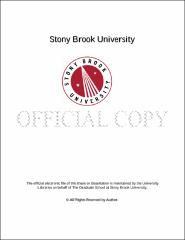| dc.identifier.uri | http://hdl.handle.net/11401/76123 | |
| dc.description.sponsorship | This work is sponsored by the Stony Brook University Graduate School in compliance with the requirements for completion of degree. | en_US |
| dc.format | Monograph | |
| dc.format.medium | Electronic Resource | en_US |
| dc.language.iso | en_US | |
| dc.publisher | The Graduate School, Stony Brook University: Stony Brook, NY. | |
| dc.type | Thesis | |
| dcterms.abstract | Gelatinous zooplankton blooms have been increasing in magnitude and frequency globally. Seasonal variations in food availability and temperature can trigger a population bloom and subsequent crash in coastal and estuarine waters. Long Island Sound (LIS) is a highly-productive urban estuary. Due to its proximity to New York City and annual summer hypoxia, there has been substantial focus on anthropogenic nutrient inputs and reductions to LIS. When determining nutrient budgets, an important process is the recycling of nutrients within a system. Gelatinous zooplankton, including the most common species in LIS, the ctenophore <italic>Mnemiopsis leidyi</italic>, are capable of high rates of nutrient regeneration. During 2011 and 2012, the population biomass of <italic>M. leidyi</italic> was monitored and nutrient regeneration rates (i.e., NH<sub>4</sub><super>+</super>, PO<sub>4</sub><super>3-</super>) were calculated based on laboratory experiments. Blooms of <italic>M. leidyi</italic> in Long Island Sound were moderate in 2011 and absent in 2012, despite an anomalously warm spring during the latter. Ctenophores in LIS have the potential, at times, to release substantial amounts of these nutrients daily, but not in quantities sufficient to support a significant amount of primary production. Upon demise of the bloom, there is also a considerable input of nutrients, but such population demise is transient and represents only a brief pulse of nutrients into the system and may be colonized rapidly by bacteria and contribute toward hypoxia. Rates of live nutrient regeneration as well as overall gelatinous zooplankton biomass can vary widely on an interannual basis, complicating the assessment of the nutrient budget for LIS. | |
| dcterms.available | 2017-09-20T16:42:24Z | |
| dcterms.contributor | Gobler, Christopher | en_US |
| dcterms.contributor | Lonsdale, Darcy J | en_US |
| dcterms.contributor | Cerrato, Robert. | en_US |
| dcterms.creator | Treible, Laura Mae | |
| dcterms.dateAccepted | 2017-09-20T16:42:24Z | |
| dcterms.dateSubmitted | 2017-09-20T16:42:24Z | |
| dcterms.description | Department of Marine and Atmospheric Science. | en_US |
| dcterms.extent | 60 pg. | en_US |
| dcterms.format | Application/PDF | en_US |
| dcterms.format | Monograph | |
| dcterms.identifier | http://hdl.handle.net/11401/76123 | |
| dcterms.issued | 2013-12-01 | |
| dcterms.language | en_US | |
| dcterms.provenance | Made available in DSpace on 2017-09-20T16:42:24Z (GMT). No. of bitstreams: 1
Treible_grad.sunysb_0771M_11422.pdf: 1328096 bytes, checksum: 43a8e8af119a4e6b724020d7bfa997b9 (MD5)
Previous issue date: 1 | en |
| dcterms.publisher | The Graduate School, Stony Brook University: Stony Brook, NY. | |
| dcterms.subject | Long Island Sound, Mnemiopsis leidyi, nutrient cycling | |
| dcterms.subject | Biological oceanography | |
| dcterms.title | The Role of the Ctenophore Mnemiopsis leidyi in Nutrient Cycling in Long Island Sound, NY | |
| dcterms.type | Thesis | |

